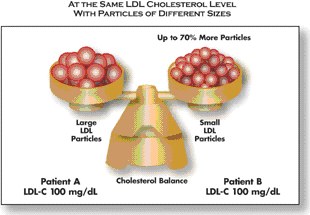
It is now a rare person who does not have at least some proportion of their LDL cholesterol as small particles. I estimate that, of the people who come to the office or report their data on the Track Your Plaque website, 90% have at least 40-50% small LDL particles. Some people have 100% small LDL particles. The sample NMR lipoprotein report shows the result for someone with a severe small LDL pattern (the tallest red bar labeled 1354 nmol/L, compared to the 74 nmol/L of the tiny red bar of large LDL.)
The nutritional approach for small vs. large LDL differs. Small LDL particles are most sensitive to carbohydrate intake; large LDL particles are more sensitive to saturated fats.
The conventional "heart healthy" diet that restricts saturated fat reduces large LDL but exerts no effect on small LDL. Thus, a diet that is restricted in saturated fat and weighed more heavily with "healthy whole grains" triggers small LDL particles. Followers of the conversations here recognize that small LDL particles are flagrant triggers for coronary plaque; they have, in fact, become the number one most common cause for heart disease in the U.S.
When you have lipoproteins tested, you can therefore gauge the likely result obtained when specific dietary changes are made. Follow the low saturated fat advice, large LDL will drop modestly, but small LDL skyrockets.

(Image courtesy Liposcience, Inc.)
Eliminate sugars, wheat, and cornstarch and you will see small LDL plummet (along with total LDL).
As an aside, my personal observation is that the "need" for statin cholesterol drugs can be reduced dramatically by paying attention to this important LDL size distinction.